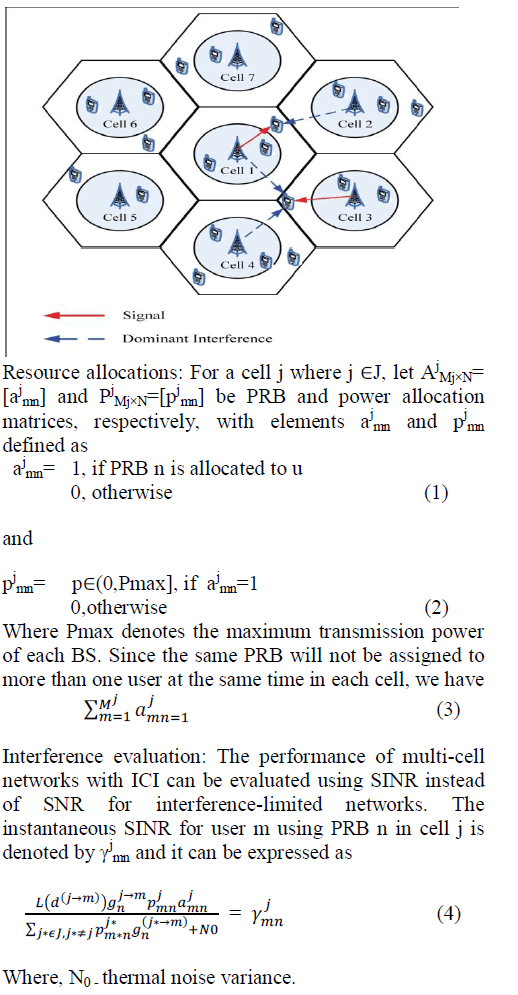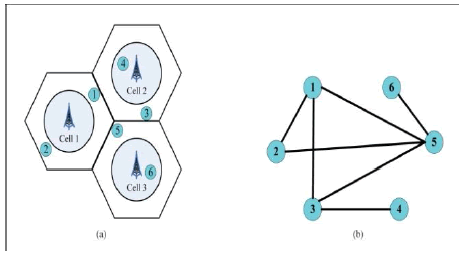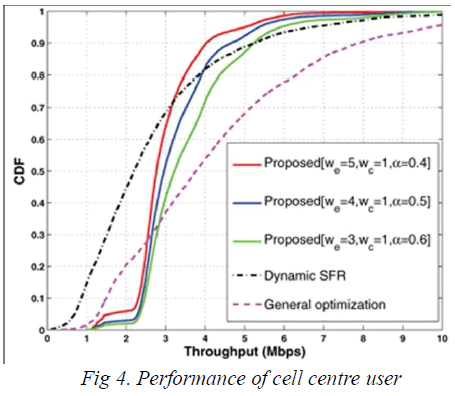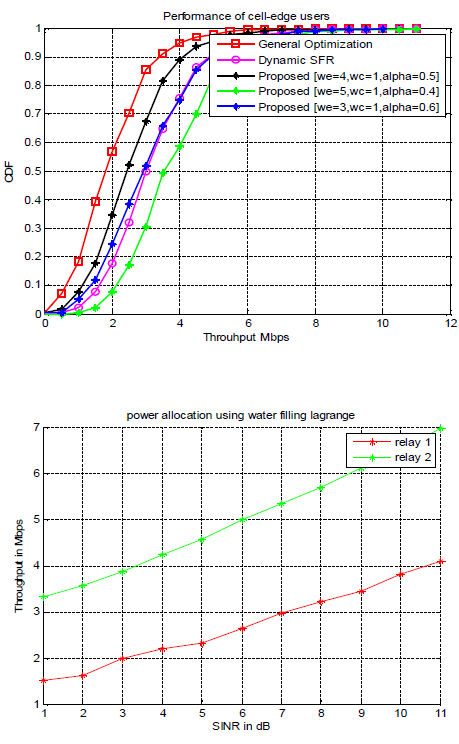In this project, a downlink resource allocation scheme for OFDMA-based next generation wireless network targets high data rate and efficient resource usage the scheme consist of radio resource and power allocation which are implemented separately. Low complexity heuristic algorithm are first proposed to achieved the radio resource allocation, where graph base framework and fine physical resource block assignment are performed to mitigate major ICI and hence improve the network performance. A novel distributed power allocation is then performed to optimize the performance of cell edge users under desirable conditions. The power optimization is formulated as an iterative barrier constrained water filling problem and solved by Lagrange method. Joint ML MMSE is used to develop simple receiver structure that gives joint ML estimates of multipath channel and the transmitted data sequence. Simulation results indicate that our proposed scheme can improve performance of cell edge users in multicell network
INTRODUCTION |
| Radio spectrum is becoming a scarce resource in
wireless communications, the orthogonal frequency
division multiple access (OFDMA) has been proposed as
a state-of-the-art air interface technology to enable high
spectrum efficiency and effectively combat frequencyselective
fading. Due to its promising features, OFDMA
is adopted in many emerging cellular systems such as the
Long Term Evolution (LTE and IEEE 802.16m) for
achieving those ambitious objectives of next generation
networks. In order to realize the flexibility on
access of radio resources, OFDMA poses a new challenge for radio resource management (RRM). A
good RRM scheme, including subcarrier allocation,
scheduling and power control, is crucial to guarantee
high system performance for OFDMA-based networks.
In future wireless networks, however, denser cellular
deployment with a lower frequency reuse factor is
demanded. This has moved the trend to the development
of RRM for multicell systems. In the multi-cell context,
inter-cell interference (ICI) has become a major issue of
concern since the frequency reuse-1 is agreed as the
preferred frequency planning deployment for modern
OFDMA-based cellular networks. Due to the same
spectral usage in adjacent cells, ICI can result in severe
performance degradation to users of reuse-1 OFDMA
networks, particularly those at the cell edge. Thus,
developing RRM schemes with an emphasis on ICI
reduction in the multicell scenario is of significant
interest to recent research work. The ICI-aware RRM in
multi-cell OFDMA networks, in general, can be
formulated as a global performance optimization
problem by considering the signal-to-interference-and
noise ratio (SINR) instead of the signal-to-noise ratio
(SNR). Unfortunately, finding the optimal solution to
such a global optimization problem is extremely hard
and normally not applicable in practice. This is because
the problem has been known as a mixed integer
programming (MIP) and proven to be NP-hard, which is
computationally prohibitive to tackle. The first category
aims at developing intelligent subcarrier (or sub channel)
allocation schemes to effectively mitigate ICI and
improve the system performance. This is known as ICI
coordination (ICIC). As the subcarrier Allocation can be
formulated as a binary integer programming (BIP) which
is an NP-hard problem as well, heuristic algorithms were proposed to simplify the process of subcarrier
allocations. The second category, on the contrary, has
mainly concentrated on using power allocation to
maximize network throughput. Unlike the subcarrier
allocation case, finding the optimal solution for power
allocation might be feasible if the formulated problem
can be proven to belong to the class of convex
optimization problems. A Lagrange dual method and
geometric programming have been proposed to tackle
such optimization problems. However, the perfect
convex structure on power allocation holds only for the
single-cell scenario in the absence of ICI. The sum rate
or system throughput of multiple cells is not convex (or
concave) in terms of the power allocated to each user.
This lack of a convex structure makes it impossible to
obtain the optimal solution in multi-cell scenarios. In a
boundary of the feasible region for such non-convex
problems has been investigated and accordingly optimal
power allocation schemes were proposed. Yet due to
high complexity, those schemes only work well in a
simple two-cell scenario and have not been tested under
the environment with high network densities. |
PROBLEM FORMULATION |
| Consider a downlink cellular network consisting of a set
of BSs denoted by J= {1,...,J},where J is the total number
of cells in the network. The total number of users in cell j
is denoted by Mj, while the number of available PRBs
that can be scheduled for downlink data transmission in
each TTI is denoted by N. Note that each BS is allowed
to use all NPRBs as the frequency reuse-1 deployment is
applied in the network. |
 |
| Optimization Problem: Here our optimization goal is to
maximize the overall throughput of cell-edge users while
maintaining the required throughput for cell-centre users.
As a result, a balanced performance improvement
between cell edge and cell-centre users is expected to be
achieved in the multi-cell systems. The reason behind this is that cell-centre users usually do not suffer from
heavy ICI and relatively high performance is easy to be
obtained for these users even in a network without
optimization, whereas cell-edge users’ performance is
much more vulnerable to ICI and their performance
improvement has to strongly rely on optimization
schemes. Thus, in this work the resource allocation are
formulated as the following maximization problem with
constraints. |
 |
| Where Mj
E and Mj
C denote the total number
of cell-edge Users and cell-centre users in the given cell
j, respectively, i.e., Mj
E+Mj
C =Mj, and Rt is a throughput
threshold Defined to satisfy cell-centre users of each cell
with preferred Performance achievement. Clearly, the
solution to this problem is not to address the general
global optimization but to achieve a better performance
balance, where different types of users in the network
can equally obtain desirable data rates regardless of their
geographical locations. |
PROPOSED RADIO RESOURCE
ALLOCATION |
| Phase I: ICIC |
| In the multi-cell context, the resource allocations have to
start with the global ICIC schemes as effective ICI
mitigation cannot be achieved only by power control
especially for those cell-edge users who are close to each
other in the network. Thus, the first phase of our
proposed radio resource allocation is to develop an ICIC
scheme using a simple but effective graph-based
framework. Our objective is to construct a graph that
reflects major interference occurring in the real time |
 |
| Fig.3 An example of the graph-based framework. (a) 3-
cell scenario. (b) Interference graph construction.
network environment. According to the graph theory ,
the corresponding interference graph is denoted by
G=(V,E), where V is a set of nodes each representing a
user in the network, and E is a set of edges connecting
users that can cause heavy mutual interference when they
are allocated the same PRB. In order to reduce
complexity, the interference intensity for edge
connections is determined solely by the geographical
location and proximity of users in the network. i.e., celledge
users suffer from severe interference due to the
shorter distances to the adjacent BSs. The information
for precise SINR measurements is not required at this
stage. For building the edge connection per pair, we
define that the edge between user a and b is connected when E(a, b)= 1,otherwise,E(a, b)=0, and note
that E(a, b)=E(b, a). |
| The basic rules of the interference graph construction are
as follows. |
| Users within the same cell are mutually
connected. |
| For any cell-edge user, the connection is only
pair wise established with other cell-edge users
of its dominant interfering cells. |
| Let Dm denote the set containing indices of dominant
interfering cells to cell-edge user m. Thus, an illustrative
example is given by Fig. 3. Fig. 3(a) presents a simple 3-
cell network case, where user 1, 2, 3 and 5 are cell-edge
users of each cell and D1 ={1},D2 =∅,D3 ={3},D5
={1,2}, respectively. Then the corresponding
interference graph is constructed in Fig. 3(b). |
Phase II: Fine PRB Assignment |
| The first phase framework offers the network with a
strategic planning for ICIC but the actual PRB allocation
has not been done yet. In the second phase, therefore, we will decide how to practically make the PRB assignment
in the network given the interference graph. This work is
also known as the colour mapping problem in general
graph theory by marking those directly connected nodes
with different colours. To reduce complexity, a heuristic
algorithm is proposed here to perform a fine PRB
allocation by taking account of the instantaneous channel
quality. Since major ICI is well looked after by the first
phase, in the second phase we consider only SNR for
simplicity by removing the interdependency issue of
SINR. SNR for user m on PRB n is calculated by, |
 |
| where j is the serving cell of user m. Let Rm
be the set of users who are allowed to have the same
PRB, or in another word, the same colour with user min
the network. Note that finding the necessary Rm is also
included in this algorithm. The PRB allocation decision
made to a user is determined not only by the
instantaneously achieved SNR but also by a weighting
factor denoted by wm. Based on the weighted SNR, the
PRB allocation that effectively achieves an overall
performance improvement with good fairness among
those two types of users in the network. On the other
hand, the proportional fairness is also considered by
taking account of the number of PRBs already occupied
and there by prevents the PRB resource allocation
schemes. On the other hand, cell-centre users are allowed
to share PRBs with all users in the network (except their
serving cells) and thereby may interfere with either celledge
or cell-centre users of the adjacent cells depending
on the PRB allocation. |
OPTIMIZATION FOR CELL EDGE USERS |
Power allocation for cell edge users |
| Given the fixed PRB allocation and power allocation of
Cell centre users, the original optimization problem P1
becomes a convex function of power of cell-edge users
and can be decomposed into J parallel sub-problems,
where the optimal power allocation to cell-edge users is
solved locally by each BS of the network. Note that such
sub-problems are defined as a series of P2, where only
mutual interference between cell-edge and cell-centre
users is taken into account. Let pj(e)
n denote the power
allocated to PRB n used by a cell-edge user in cell j.
Therefore, the objective of P2 for cell j is expressed |
 |
| Where hj
n(hj∗n) denotes the combined channel impact on
PRB n in cellj(j∗) including the channel gain and path loss
fading components presented in (3), i.e.,hj
n=g(j→m)
n
Ld(j→m), and Sn is a set of neighbouring cells in the
network (i.e.,j∗=j,∀j∗∈J) , in which PRB n is used by a
cell-centre user at the moment. The idea of P2 is to use
power allocation to maximize performance of cell-edge
users under the constraint that performance of cell-centre
users is not largely sacrificed. Power allocation to celledge
users has to be conditionally optimized in order not
to generate unacceptable interference to cell-centre users
in the network. In addition, here we assume that the
required information about the power allocation of cellcentre
users in adjacent cells is known by each BS,
which in fact are achievable in future wireless networks
where specific links, such as the X2 interface in LTE are
built to connect BSs for necessary information exchange
among them. |
 |
SIMULATION RESULTS |
| The proposed scheme can consistently balance the
performances of cell edge users and cell centre users |
 |
CONCLUSION AND FUTURE WORK |
| As a result, proposed resource allocation scheme
improves the performance of cell-edge users which
allows for future wireless networks to deliver consistent
high-performance to any user form anywhere. For future
enhancement, simulation of handoff technique is said to
be done in LTE network and MIMO - OFDM is
compared in terms of BER. |
References |
- D. Astely, E. Dahlman, A. Furuskar, Y. Jading, M. Lindstrom, andS. Parkvall, âÃâ¬ÃÅLTE: the evolution of mobile broadband âÃâ¬Ãâ [LTE part II:3GPP release 8],âÃâ¬ÃÂIEEE Commun. Mag., vol. 47, no. 4, pp. 44âÃâ¬Ãâ51,2009.
- K. Etemad, âÃâ¬ÃÅOverview of mobile WiMAX technology andevolution,âÃâ¬ÃÂIEEECommun. Mag., vol. 46, no. 10, pp. 31âÃâ¬Ãâ40, 2008.
- Z. Shen, J. G. Andrews, and B. L. Evans, âÃâ¬ÃÅAdaptive resourceallocation in multiuser OFDM systems with proportional rateconstraints,âÃâ¬Ã IEEE Trans. Wireless Commun., vol. 4, no. 6, pp. 2726âÃâ¬Ãâ2737, 2005.
- Y. Lin, T. Chiu, and Y. Su, âÃâ¬ÃÅOptimal and near-optimal resourceallocation algorithms for OFDMA networks,âÃâ¬Ã IEEE Trans. WirelessCommun.,vol. 8, no. 8, pp. 4066âÃâ¬Ãâ4077, 2009.
- J. Jang and K. Lee, âÃâ¬ÃÅTransmit power adaptation for multiuserOFDM systems,âÃâ¬Ã IEEE J. Sel. Areas Commun., vol. 21, no. 2, pp. 171âÃâ¬Ãâ178, 2003.
|